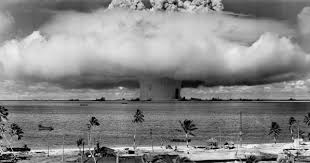 by Bruce Bethke
by Bruce BethkeI'm off on something of a tangent today. I started out to write about how the development of the gun, and especially the development of the ship-borne gun, essentially changed—well, everything. The history of the world. The balance of power between nations. The developmental paths of entire peoples and cultures, depending on who had guns, and who didn't. But then I got thinking about an even more fundamental issue.
Gunpowder.
Fascinating stuff, gunpowder. It was only after the development of the first nitrocellulose-based powders that it became necessary to differentiate, and call this new thing smokeless powder and that old original thing black powder. For most of the past millennium "gunpowder" has meant simply the correct mixture of three common ingredients: nitre, sulfur, and charcoal. Basic high school chemistry, or probably even predating that and being alchemy. Captain Kirk found enough of the stuff just laying around loose on the surface of the planet Omigoshandgolli IV to build a crude hand-cannon and whack the Gorn, in the episode, "Arena," which was both adapted from the far superior short story of the same name written by Fredric Brown and ruined by giving it the usual Star Trek space hippie peace and love ending. But never mind that now.
Kirk just found the components of gunpowder? What an astonishing occurrence. Because the more I think about it, the more I realize that gunpowder must be a really unique thing in the universe, tied as tightly as it is to our terrestrial biochemistry. What are those ingredients again?
Sulfur: okay, that's no big deal. Elemental sulfur occurs everywhere. There are volcanoes of sulfur on the moons of Jupiter. Nothing terribly special about sulfur. You just need to find it, which you'll usually do near an active or geologically recently extinct volcano.
Charcoal: that ups the ante some. Coal won't do; graphite won't do; pure carbon fails. You must have charcoal to make gunpowder, which is to say, partially burned and then smothered plant material, which forms a carbon and cellulose matrix of a particular nature. And not just any old charcoal, either: willow charcoal works best, although alder, hazelwood, and old grape vines will serve, and even charcoalized linen fabric has been used in a pinch. But to have charcoal requires a particular kind of arboreal ecology, and an oxygen atmosphere in which the organic material can be partially burnt, and then snuffed out at just the right moment.
It's the third ingredient that's the kicker, though: nitre, a.k.a. saltpeter, from the Latin sal petrae, the "salt of stones." While it's generally thought of as potassium nitrate, classical saltpeter can also be sodium nitrate, calcium nitrate, or a blend of all three. In any case, all known nitrate salts are the product of the same process: the microbially assisted decomposition of digestively processed organic materials.
Which is to say, composted manure.
I'm certain there must be an inorganic way to synthesize the stuff, but for most of the past thousand years there have been two ways to produce it: either by carefully tending a large manure pile until nitre crystals form in usable size and quantity—and petering plantations certainly contributed to making Europe a more pungent continent from the 14th through 19th centuries—or by finding fossil deposits of it, in the form of caves filled with composted bat guano or islands covered with composted bird droppings. In either case, it starts out as excrement, from our particular kind of digestive tract, implying our particular sort of biochemistry. And the diet that produces that manure is important, too, at least in terms of how quickly and effectively it decomposes to yield nitre.
Truly fascinating stuff, gunpowder. It's lightweight, readily portable, and if handled with reasonable precautions, relatively safe. Yet introduce an ignition source—a tiny spark or ember will do—and suddenly the entire mass of it combusts in an instant, releasing an incredible amount of energy. Pack it into a hole drilled into rock, and it can shatter mountains. Put it in a tube that is closed at one end and has a loosely fitting plug at the other, and the plug is propelled outward with remarkable velocity. Put it in a lighter tube; use no projectile but rather simply constrict the size of the exit hole; and the rush of expanding hot exhaust gasses can propel the tube itself to considerable distances, again, at remarkable velocities.
So here's today's question. On Earth, all known rocketry experiments began with gunpowder, before moving on to other propellants. Even today, the dream of spaceflight always seems to start with launching tiny gunpowder-powered rockets in parks and pastures. And gunpowder, as I've shown, is an artifact of our biochemistry.
Would it even be possible for a species that does not share our particular and peculiar form of biochemistry, and that did not at some point in its history invent the gun, to have the dream of someday reaching the stars, and in time to become spacefarers?
Submitted for your consideration,
~brb












